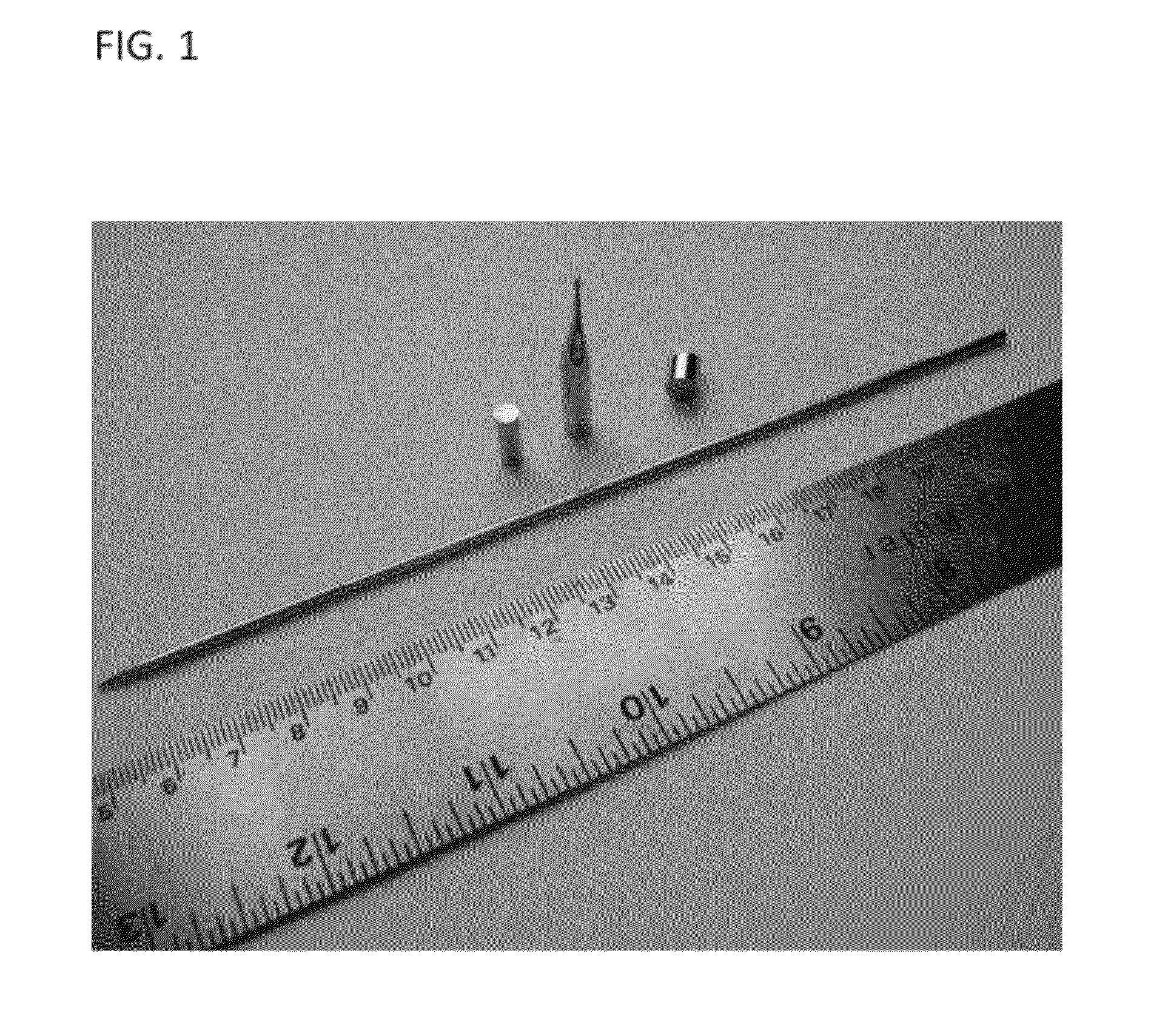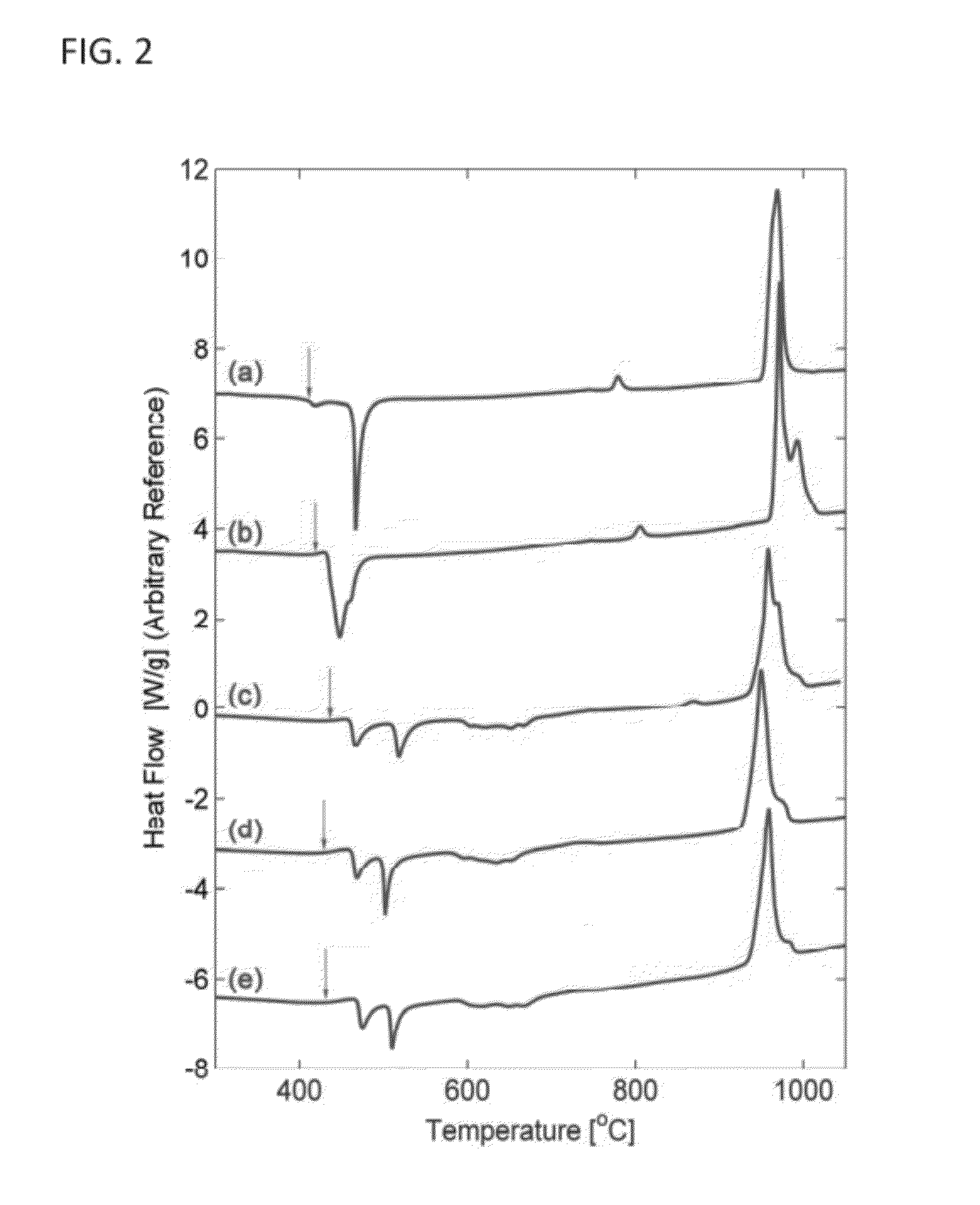Tough iron-based bulk metallic glass alloys
a bulk metal and alloy technology, applied in the direction of magnetism of inorganic materials, magnetic materials, magnetic bodies, etc., can solve the problems of low-cost ultra-strong materials, fracture toughness values, and compromise of glass forming ability, so as to achieve the highest possible toughness
- Summary
- Abstract
- Description
- Claims
- Application Information
AI Technical Summary
Benefits of technology
Problems solved by technology
Method used
Image
Examples
example 1
Compositional Survey
[0107]Alloys developed based on this compositional survey along with the associated critical rod diameters are listed in Table 1, below. Thermal scans are presented in FIG. 2, and Tg for each alloy is listed in Table 1. The measured shear and bulk moduli along with the molar volumes of (Fe74.5Mo5.5)P12.5(C5B2.5), (Fe70Mo5Ni5)P12.5(C5B2.5), and (Fe68Mo5Ni5Cr2)P12.5(C5B2.5) are also listed in Table 1. As seen in Table 1, the exemplary Fe-based alloys are capable of forming glassy rods with diameters ranging from 0.5 mm to 6 mm, and exhibit shear moduli of less than 60 GPa, in accordance with the criteria set forth in this invention.
TABLE 1Compositional SurveyTgdcvmKQ [MPaComposition[° C.][mm][m3 / mol]G [GPa]B [GPa]m1 / 2]Fe80P12.5C7.5 (prior art4050.05*—56†—32‡alloy)Fe80P12.5(C5B2.5)4120.5————(Fe74.5Mo5.5)P12.5(C5B2.5)42936.85 × 10−656.94 ± 0.09145.0 ± 0.353.1 ± 2.4(Fe70Mo5Ni5)P12.5(C5B2.5)42346.89 × 10−657.31 ± 0.08150.1 ± 0.449.8 ± 4.2(Fe68Mo5Ni5Cr2)P12.5(C5B2.5)426...
example 2
Toughness—Glass-Forming Ability Relation for the Inventive Alloys
[0110]In FIG. 4 the trend of decreasing toughness with increasing glass-forming ability is exemplified by plotting the notch toughness KQ against the critical rod diameter cl, for (Fe74.5Mo5.5)P12.5(C5B2.5), (Fe70Mo5Ni5)P12.5(C5B2.5), and (Fe68Mo5Ni5Cr2)P12.5(C5B2.5). Interestingly, the plot reveals that this trend is roughly linear. On the same plot we also present KQ vs. cl, data for the Fe-based glassy alloys developed by Poon and co-workers (cited above), and investigated by Lewandowski and co-workers (cited above). A linear regression through the data reveals a toughness vs. glass-forming ability correlation of similar slope but lying well below the correlation demonstrated by the present data.
[0111]The much higher toughness for a given critical rod diameter exhibited by the inventive alloys compared to prior art alloys is attributed to their much lower shear modulus. (See Demetriou et al. cited above.) The compos...
example 3
Magnetic Properties for the Inventive Alloys
[0112]In another embodiment, the magnetic properties of the alloys were explored. In particular, the current embodiment explores the optimization of the bulk ferromagnetic alloy compositions to improve the soft magnetic properties while maintaining high toughness and glass-forming ability.
[0113]Background
[0114]Both inductors and transformers are essential components in power electronics as a means for storing magnetic energy and converting from one voltage to another. Since both involve modulating the magnetization of a material through AC current, it is necessary to find a material that is easily magnetized with minimal energy loss. Amorphous metal alloys fit this requirement, and are increasingly being adopted as transformer and inductor cores.
[0115]There are a number of magnetic properties that must be taken into consideration when choosing a material for use in power electronics. First, the material's saturation magnetization (Ms), whi...
PUM
| Property | Measurement | Unit |
|---|---|---|
| diameter | aaaaa | aaaaa |
| coercivity | aaaaa | aaaaa |
| Tg | aaaaa | aaaaa |
Abstract
Description
Claims
Application Information
 Login to View More
Login to View More - R&D
- Intellectual Property
- Life Sciences
- Materials
- Tech Scout
- Unparalleled Data Quality
- Higher Quality Content
- 60% Fewer Hallucinations
Browse by: Latest US Patents, China's latest patents, Technical Efficacy Thesaurus, Application Domain, Technology Topic, Popular Technical Reports.
© 2025 PatSnap. All rights reserved.Legal|Privacy policy|Modern Slavery Act Transparency Statement|Sitemap|About US| Contact US: help@patsnap.com



